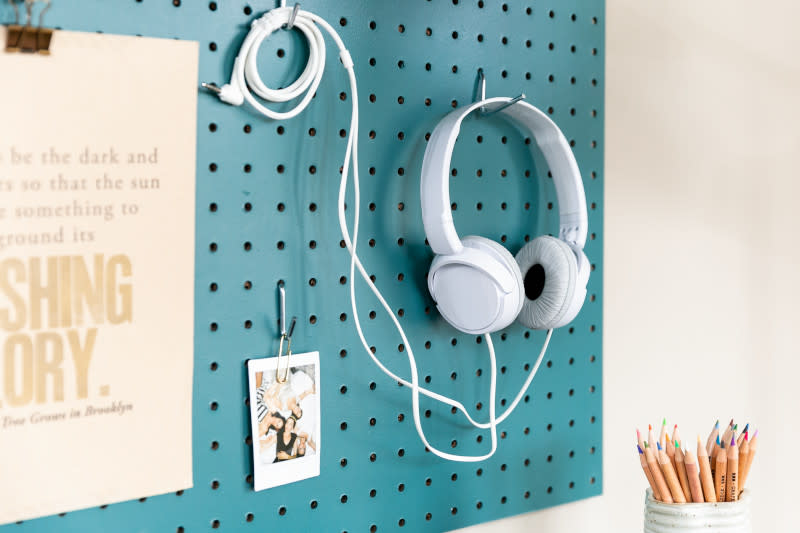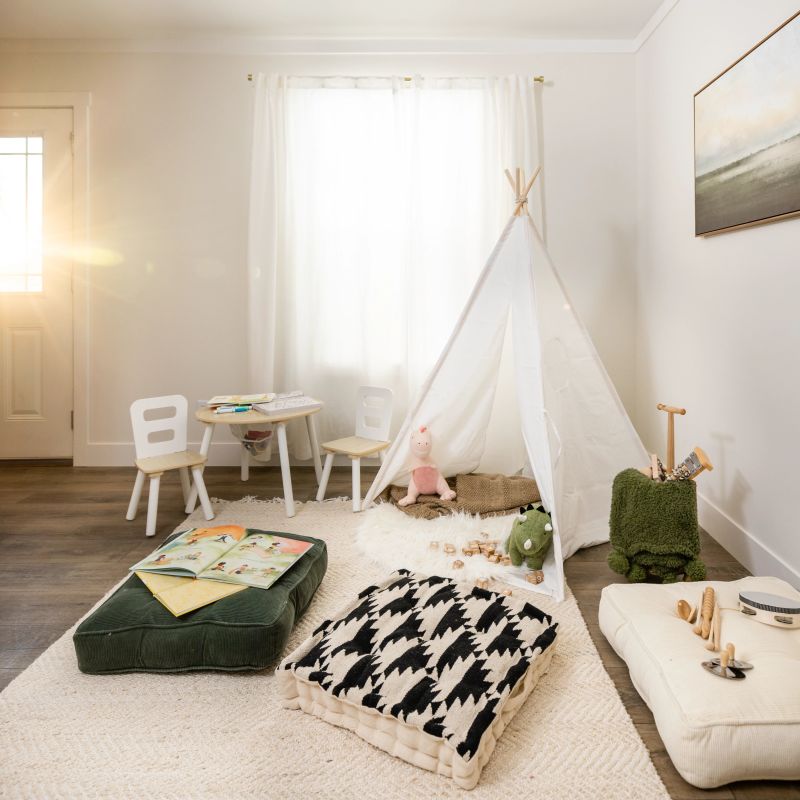Organize Your Life: Decluttering Your Kid’s Bedroom

Keeping your kid’s bedroom organized and clutter-free can be a tall order. Simplify it with Clayton’s list of decluttering tips, from choosing multifunctional furniture to ideas for using vertical space.
Have a kid’s bedroom on your hands that would make Marie Kondo turn and run? Trust us, we get it. It’s challenging enough to keep the rest of a home tidy, and between piles of toys, outgrown clothes and school papers, kids’ rooms have a way of getting extra messy. Not only that, but we probably all remember saying our rooms were clean as kids after shoving everything we could fit into the closet or under the bed. (Any space a parent might not check was fair game!)
In short, kids’ bedrooms are tough to keep truly clean and decluttered. And that’s true whether your child is in their terrible twos or their teens. But maintaining an organized, purposeful space is as key to removing headaches for you as it is to creating a sense of peace and calm for your child. We all want a visually soothing space to call our own where we can unwind and feel creative. The trick for orderly kids’ bedrooms is to aim for realistic goal posts to avoid those “I can’t find my shoes” sneak attacks.
So whether you’re a first-time parent or have a full house, keep reading for our tips to help you actually organize your kid’s room — and keep it that way.

1. Take inventory.
First things first: It’s a lot easier to organize when you have less stuff. Start by sorting through all your child’s clothes, toys and random collections with them. Even if you have younger kids, encourage them to be part of the process by asking them to show you their favorite toys. That invites them to take pride and ownership in their room, and it also ensures nothing precious accidentally gets donated.
To avoid feeling overwhelmed, divide your inventory into categories to tackle, saving the closet for last. Items will inevitably be added to it as you clean the rest of the room, and this way, you can organize it all at once.
As you sort through everything, work your way from the ground up. Floors tend to be magnets for extra-dense clutter, like small toys and cast-off crayons, and you’ll need the space clear to make orderly in-and-out piles. And speaking of those piles, keep them contained to bins that are separated by action: keep, discard, repair, and donate or sell. You may want to add your own “keep” bin, too, for sentimental items like their first soccer jerseys or no-longer-read books that are ready for storage.
Noticing that your child is a little less interested in adding to the “give away” pile? File away our next tip to help you out.
2. Know your plan for encouraging donations and discards.
Agreeing to let go of belongings can be tough for kids. And that makes sense! You never know what emotional ties your child may have to something that looks like clutter to you, and items like rocks and doodled-on papers may carry meanings you aren’t aware of.
It isn’t the most realistic to assume kids will gleefully give things away without encouragement, and rules like “one in, one out” are easily forgotten, too. Instead, use this decluttering exercise as an opportunity to explain to your child the importance of sharing things like extra toys and clothes with children who need them. Even better can be showing them items you personally are donating, and making it a family effort.
For older kids, you could also encourage them to downsize their clutter by helping them host a yard sale or post certain belongings to a supervised Facebook Marketplace account, allowing them to keep whatever money they make.
3. Create a dedicated “special things” drawer or box.
Now, you’ve set aside everything you plan to discard and donate. When sorting your remaining items, stick to the old principle of a “place for everything and everything in its place” by letting your child choose a drawer or bin for sentimental items. This way, they know they have a special place to store things with personal meaning to them, without all of those items sitting out on shelves or other surfaces.
4. Designate a “lost and found” box.
While you’re adding items to bins, go ahead and set one aside to be a permanent “lost and found” space. Tell your child that stray items that don’t immediately have a home, like single socks or parts of toys, can go here. Once a week or whenever the box is full, you and your child can go through the box and put everything where it belongs.
And once you have any outgoing items or trash packed up and out of the room, you can begin to think about organizing what’s left. For that, we recommend you head to our next tip.

5. Use the walls.
It’s time to think vertically. If you have empty wall or door space, there are several storage solutions you can use to tidy up the room, like:
- Over-the-door shoe holders with pockets that don’t have to be used just for shoes. You can easily store dolls and small toys, jewelry and hair accessories, Legos by color (Definitely don’t want those on the floor!) and more.
- Shelves, from metal floating shelves to simple spice racks, can be used to organize books, records, video games and console controllers, art supplies and more. You can also create a reading nook or corner with shelves on the wall above a soft seating area.
- Netting is a great option for holding plushies and soft toys and keeping them up and out of the way.
- Hanging racks and magnet, peg, or cork boards are also pieces that come in handy. Hang dress-up clothes, jackets and backpacks on pegs, and stick race cars, letter and storyboard magnets, artwork and supplies, headphones, charging cords and more on the walls to save space.
- Folding desks that can be pulled down or put up gives your child’s room some flexibility for when they need somewhere to do homework or be creative but also want extra room to play.

6. Invest in multipurpose furniture and pieces.
We’ve previously recommended multipurpose furniture for nurseries, like cribs that can convert into a first “big kid” bed or dressers that combine clothing storage with diaper stations. But versatile pieces work great for older children’s bedrooms as well.
For beds, you have a couple of routes to take. Loft beds are similar to bunk beds, but instead of having a bottom bunk, they feature a built-in desk or an open space that can easily become a play area. You can also get a bed with drawers underneath or cubbies built into the headboard. If you’ve already invested in a bed, opt for smaller, slidable totes to store underneath it so you can easily pull them out when needed.
Rolling carts and tables with drawers and cubbies can make excellent small desks or work areas, too, while still keeping everything in place. And seating with secret storage, like ottomans or benches that double as toy chests, gives your kids more places to keep their things without taking up extra room. You can also buy foam piece sets that can be configured into seating, like a couch, or be rearranged for make-believe play.

7. Give everything a place.
We touched on this before: No matter what ages your children are, teaching them that everything has its own designated place or home will make organization feel more natural to them. Here are just a few storage ideas to make your kid’s room more navigation-friendly:
- Have cubbies or baskets for toys, games and books.
- Buy a desktop and drawer organizer if your child has a desk so that pencils, markers and paper all have a spot to neatly go in.
- Label bins clearly, especially for smaller items, so your kids don’t have to drag out everything to find the one toy they want.
- Hang up clothes by type and color so they are easy to recognize.
- Put a clothes hamper in their room so clothes don’t end up on the floor.
A major plus of using these organizational systems? Because things will be easier to find, you won’t be asked where items are as often. Make sure that all everyday items or commonly played with toys are in cubbies, baskets or bins that are within reach. Remember, vertical space is your friend!

8. Create room zones.
With kids’ rooms, it’s easy for everything to get everywhere. Dividing a room into dedicated zones makes daily or weekly tidy-ups faster and prevents the space from becoming one large catch-all.
Beyond a rest zone, other zones that may make sense for your child’s room include:
- A creative zone. Containing mess-prone activities like crafts to one area makes clean-up easier and keeps the rest of the room organized.
- A homework zone. Even if your child is using a fold-down desk like the type we mentioned earlier, you can still keep a cart with all of their necessary supplies like pencils, paper and books in one fixed spot. A bonus of homework zones? They can create a more focused environment for learning, too.
- A drop zone. If you don’t have a mudroom or family drop zone near your home’s entrance or garage, having one in your kid’s room can be a lifesaver. Add hooks by the door for backpacks and jackets, a rack for shoes, and a cubby or basket with folders for school papers. This is also a great place to put a hamper or trash can so kids can clear school bags of any trash or dirty gym clothes. At the end of each night, finished homework and signed permission slips — along with a clean outfit, water bottle and snacks for the next day — now have a home.

9. Schedule regular organizational time.
Finally, to stay on top of clutter, build organization into your and your child’s routine. Make nightly “tidy time” part of kids’ bedtime rituals, which will help you keep mess to a minimum. Do bigger organization overhauls as often as once a month or every three months, with the biggest cleans scheduled around when your child may be receiving more items at once, like over their birthday or at the start of the school year. The exact schedule is up to you, but the important thing is making it a habit.
Parenting is tough enough without extra clutter. To keep the chaos at bay in your home, check out our complete guide to home organization that breaks down how to tackle the mess room-by-room and find more decluttering ideas with our Organize Your Life series.
Are you ready to find your dream home?
Start shopping now or find a home center in your area to learn more about Clayton Built® home options.By entering your email address, you agree to receive marketing emails from Clayton. Unsubscribe anytime.
© 1998-2025 Clayton.




